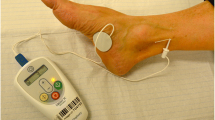Abstract
Introduction
Fecal incontinence (FI) is a multifactorial disease that affects patients’ quality of life. The aim of this study was to evaluate the efficacy of posterior tibial nerve stimulation (PTNS) in the treatment of FI and to assess the medium-term results.
Methods
A prospective cohort of patients with FI treated with PTNS between 2012 and 2014 was analysed. Endoluminal ultrasound and anorectal physiologic studies were performed in all patients. The efficacy of PTNS was assessed using a validated questionnaire (Cleveland Clinic Incontinence Score) at baseline, after treatment, and 2 years later. The Vaizey score was also used at 2-year follow-up to assess urge incontinence.
Results
Fifty-six patients (38 females; mean age 59.7 years) with FI were treated. The causes of FI were mainly obstetric injury and previous colorectal surgery. A decrease of 50% from baseline CCIS was seen in 41.1% of patients after PTNS. One-third maintained a minimum of 50% decrease of their initial CCIS after 2 years. Comparing CCIS at baseline, after treatment, and at 2-year follow-up, a statistically significant difference was observed (p < 0.0001 and p < 0.0004 respectively). Medium-term improvement was not maintained in patients with passive and mixed FI, while it was maintained in those with urge incontinence. At 2 years, patients with mild incontinence maintained the greatest response.
Conclusions
PTNS is a safe, effective, non-invasive treatment for FI with good results in almost half of the patients at the end of the treatment. There is also an acceptable maintained response at 2-year follow-up. It seems to be most successful in patients with mild incontinence and urge incontinence.
Similar content being viewed by others
References
Benezech A, Bouvier M, Vitton V (2016) Faecal incontinence: current knowledges and perspectives. World J Gastrointest Pathophysiol 7(1):59–71
Johanson JF, Lafferty J (1996) Epidemiology of fecal incontinence: the silent affliction. Am J Gastroenterol 91(1):33–36
Madoff RD, Parker SC, Varma MG, Lowry AC (2004) Faecal incontinence in adults. Lancet 364:621–632
Norton C, Cody JD (2012) Biofeedback and/or sphincter exercises for the treatment of faecal incontinence in adults. Cochrane Database Syst Rev. https://doi.org/10.1002/14651858.CD002111.pub3
Shafik A, Ahmed I, El-Sibai O, Mostafa RM (2003) Perrcutaneous peripheral neuromodulation in the treatment of fecal incontinence. Eur Surg Res 35(2):103–107
Gupta P, Ehlert MJ, Sirls LT et al (2015) Percutaneous tibial nerve stimulation and sacral neuromodulation: an update. Curr Urol Rep 16(2):4. https://doi.org/10.1007/s11934-014-0479-1
Cooperberg MR, Stoller ML (2005) Percutaneous neuromodulation. Urol Clin N Am 32(1):71–78 (vii. Review)
Peña Ros E, Parra Baños PA, Benavides Buleje JA, Muñoz Camarena JM, Escamilla Segade C, Candel Arenas MF, Gonzalez Valverde FM, Albarracín Marín-Blázquez A (2016) Short-term outcome of percutaneous posterior tibial nerve stimulation (PTNS) for the treatment of faecal incontinence. Tech Coloproctol 20(1):19–24
Thomas GP, Dudding TC, Rahbour G, Nicholls RJ, Vaizey CJ (2013) A review of posterior tibial nerve stimulation for faecal incontinence. Colorectal Dis 15:519–526
Horrocks EJ, Thin N, Thaha MA et al (2014) Systematic review of tibial nerve stimulation to treat faecal incontinence. Br J Surg 101:457–468
Tan E, Ngo NT, Darzi A, Shenouda M, Tekkis PP (2011) Meta-analysis: sacral nerve stimulation versus conservative therapy in the treatment of faecal incontinence. Int J Colorectal Dis 26:275–294
Edenfield AL, Amundsen CL, Wu JM, Levin PJ, Siddiqui NY (2015) Posterior tibial nerve stimulation for the treatment of fecal incontinence: a systematic evidence review. Obstet Gynecol Surv 70(5):329–341
Knowles CH, Horrocks EJ, Bremner SA, Stevens N, Norton C, O’Connell PR (2015) Percutaneous tibial nerve stimulation versus sham electrical stimulation for the treatment of faecal incontinence in adults (CONFIDeNT): a double-blind, multicentre, pragmatic, parallel-group, randomised controlled trial. Lancet 386(10004):1640–1648
De la Portilla F, Rada R, Vega J, González CA, Cisneros N, Maldonado VH (2009) Evaluation of the use of posterior tibial nerve stimulation for the treatment of fecal incontinence: preliminary results of a prospective study. Dis Colon Rectum 52(8):1427–1433. https://doi.org/10.1007/DCR.0b013e3181a7476a
Glasgow SC, Lowry AC (2012) Long-term outcomes of anal sphincter repair for fecal incontinence: a systematic review. Dis Colon Rectum 55:482–490
Halverson AL, Hull TL (2002) Long-term outcome of overlapping anal sphincter repair. Dis Colon Rectum 45:345–348
Hotouras A, Murphy J, Walsh U, Allison M, Curry A, Williams NS, Knowles C, Chan CL (2014) Outcome of percutaneous tibial nerve stimulation (PTNS) for fecal incontinence: a prospective cohort study. Ann Surg 259(5):939–943
Marti L, Galata C, Beutner U, Hetzer F, Pipitone N, Wolff K, Borovicka J, Brunner W, Sulz MC, Maurus C (2017) Percutaneous tibial nerve stimulation (pTNS): success rate and the role of rectal capacity. Int J Colorectal Dis 32(6):789–796
Van der Wilt AA, Giuliani G, Kubis C, van Wunnik BPW, Ferreira I, Breukink SO, Lehur PA, La Torre F, Baeten CGMI (2017) Randomized clinical trial of percutaneous tibial nerve stimulation versus sham electrical stimulation in patients with faecal incontinence. Br J Surg 104(9):1167–1176
Author information
Authors and Affiliations
Corresponding author
Ethics declarations
Conflict of interest
The authors have no commercial associations that might be a conflict of interest in relation to this article.
Ethical approval
All procedures performed in studies involving human participants were in accordance with the ethical standards of the institutional and/or national research committee and with the 1964 Helsinki Declaration and its later amendments or comparable ethical standards.
Informed consent
Informed consent was obtained from all participants.
Rights and permissions
About this article
Cite this article
Hidalgo-Pujol, M., Andriola, V., Jimenez-Gomez, L.M. et al. Medium-term outcome of percutaneous tibial nerve stimulation in the treatment of fecal incontinence. Tech Coloproctol 22, 875–879 (2018). https://doi.org/10.1007/s10151-018-1892-0
Received:
Accepted:
Published:
Issue Date:
DOI: https://doi.org/10.1007/s10151-018-1892-0




